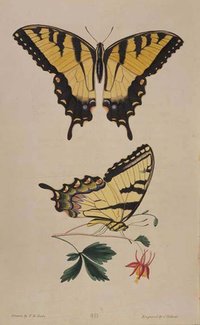Thomas Say
|
|
Say_Thomas_1787-1834.png
Thomas Say (June 27, 1787 – October 10, 1843) was an American naturalist, entomologist, malacologist and carcinologist. He was a taxonomist and is often considered to be the founder of descriptive entomology in the United States.
Thomas Say was born in Philadelphia into a prominent Quaker family. He was the great grandson of John Bartram, and the great-nephew of William Bartram, whom Say frequently visited as a boy with butterfly and beetle specimens.
Say became an apothecary in his native town, but his interests soon turned to nature and he became a self-taught naturalist. In 1812 he became a charter member and founder of the Academy of Natural Sciences of Philadelphia (ANSP).
In 1816 he met Charles Alexandre Lesueur (1778-1846), a French naturalist, malacologist, and ichthyologist who also became a member of the Academy and later its curator, between 1816 and 1824.
Say began his work on American Entomology at the Academy. He began a tradition of expeditions to collect specimens of insects. These expeditions were not without risks: Indian attacks, dangers of the frontier, hazards of traveling in wild countryside.
In 1818 Say accompanied his friend William Maclure (1763-1840), president of the ANSP (1817-1840) and father of American geology, Gerhard Troost, a geologist, and other members of the Academy on a geological expedition to the off-shore islands of Georgia and Florida, then a Spanish colony.
In 1819-1820, Major Stephen Harriman Long led an exploration to the Rocky Mountains and the tributaries of the Missouri River with Thomas Say as zoologist. The official account of this expedition included the first descriptions of the Coyote, Swift Fox, Western Kingbird, Band-tailed Pigeon, Rock Wren, Say's Phoebe, Lesser Goldfinch, Lark Sparrow, Lazuli Bunting and Orange-crowned Warbler.
In 1823, Say served as chief zoologist in Long's expedition to the headwaters of the Mississippi River.
Thomas Say travelled on the famous "Boatload of Knowledge" to an utopian society experiment, the "New Harmony Settlement" in Indiana (1826-1834), a venture of Robert Owen. One of the passengers was Lucy Way Sistare, whom Say married secretly near New Harmony on January 4, 1827. She was an artist and illustrator of specimens (such as in the book 'American Conchology') who later became the first female member of the Academy. He was accompanied by Maclure, Lesueur, Francis Neef, an educator, and Gerhard Troost. There he later met another naturalist, Constantine Samuel Rafinesque-Schmaltz (1783-1840).
In the settlement of New Harmony, Thomas Say carried on his monumental work describing insects and mollusks, leading to two classic works:
- American Entomology, or Descriptions of the Insects of North America, 3 volumes, Philadelphia, 1824-1828.
- American Conchology, or Descriptions of the Shells of North America Illustrated From Coloured Figures From Original Drawings Executed from Nature, Parts 1 - 6, New Harmony, 1830-1834; Part 7, Philadelphia, 1836.
During their years in New Harmony both Say and Lesueur experienced considerable difficulties. Say was a modest and unassuming man, living frugally, like a hermit, abandoning commercial activities and devoting himself to his studies.
He died, apparently from typhoid fever, in New Harmony, Indiana, on 10 October 1834, only 47 years old.
Say described over 1,000 new species of beetles and over 400 species of insects of other orders. No single individual before had discovered more new species than him.
Other zoologists honored him by naming several species after him, such as
- Say's Mud Crab, Caribbean Mud Crab Dyspanopeus (Neopanope) sayi (Smith 1869)
- Lanceola sayana (Bovallius 1885), an amphipod from the family Lanceolidae
- Say's Phoebe, Sayornis saya (Bonaparte 1825), a bird in the tyrant flycatcher family.
Reference
- John L. Le Conte, The Complete Writings of Thomas Say on the Entomology of North America, two volumes, Baillière Brothers, New York, 1859
External links:
- Bird names honoring Thomas Say (http://faculty.evansville.edu/ck6/bstud/saybirds.html)
- Insect names honoring Thomas Say (http://faculty.evansville.edu/ck6/bstud/saybugs.html)
- Fishes named honoring Thomas Say (http://faculty.evansville.edu/ck6/bstud/sayfish.html)
- New Harmony (http://faculty.evansville.edu/ck6/bstud/nh.html)fr:Thomas Say

